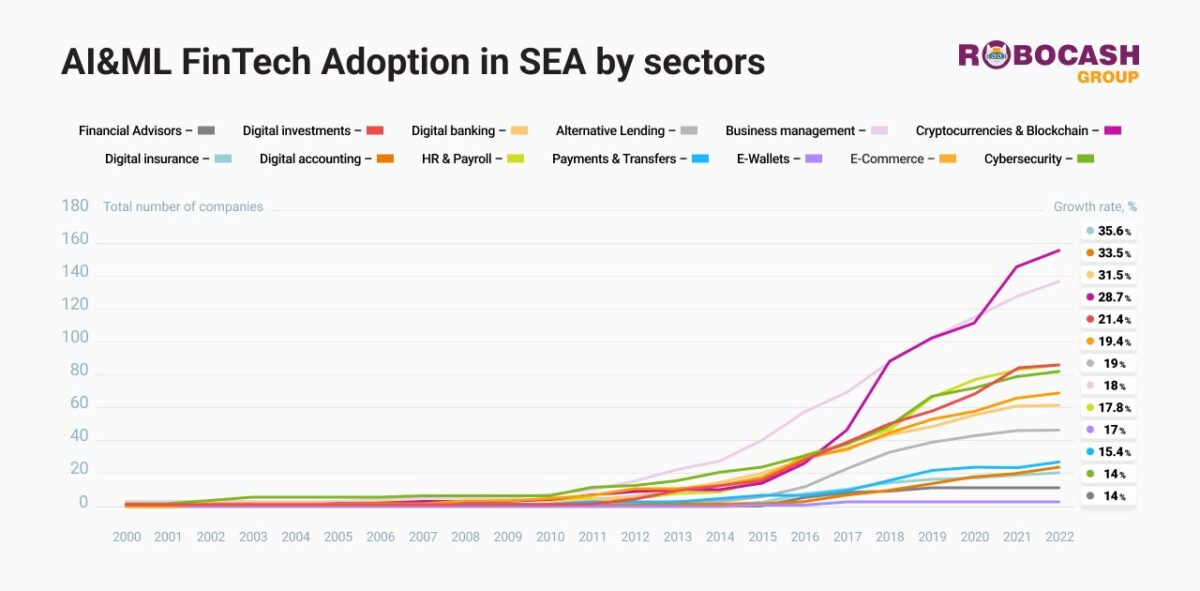Artificial intelligence (AI) and machine learning (ML) comprise only 3.1 per cent of South-East Asia fintech’s operations, indicating an abundance of potential for the technology.
South-East Asia fintech is beginning to leverage the potential of AI and ML despite an observed plateau, and its use must be operation- and objective-specific to maximise the benefits.
This statement is thoroughly emphasised throughout the findings of Robocash Group‘s latest investigation into the current adoption of these technologies within the region, including who and where it’s being applied best. Its assessment was based on the share of 26,105 regional fintechs that have AI and ML tools in their technology stack.
Top players
Out of the countries surveyed, which include Singapore, Thailand, Malaysia, Bangladesh, Indonesia, Cambodia, Philippines, Vietnam, Laos, Myanmar and Brunei, the highest rate of AI and ML penetrations in fintech was witnessed in Singapore.
Exactly 5.36 per cent of fintechs from the city-state had the tools in their stack in 2022, which the findings attribute to its especially high level of digitalisation and private fintech investment in AI.
Additionally, the country has seen a high overall economic development, being about 0.5 per cent of global GDP.
As a result, the research measures penetration in Singapore as 2.27 per cent above the SEA average of 3.09 per cent, or 807 companies. On a whole in 2022, 97 per cent of its citizens had access to the internet, 94.4 per cent had smartphones and 97 per cent had a financial account.
Thus Singapore boasts an environment that cultivates the use of the most innovative technology.
Twelve hundred miles away, the research also identifies Laos for its equally as promising fintech penetration rate of AI and ML at 4.08 per cent.
Fintech development is still in its infancy in Laos, with only 49 companies out of 26,105 in the region, meaning that even a small penetration in the sector is significant.
Sector analysis
The digital insurance sector holds the highest penetration rate of AI and ML technologies, with the number of companies using the technology growing at an average of 35.6 per cent per year. An example of this includes general insurer MSIG Singapore coming together with Fermion Merimen in February of this year to combat motor insurance fraud with the power of AI.
Just below this are the digital accounting sector at 33.5 per cent and the digital banking sector at 31.5 per cent.
The research recognises the broader scale of adoption taking place across SEA’s fintech landscape, pinpointing average increases across cryptocurrency and blockchain at 28.7 per cent, digital investments at 21.4 per cent and e-commerce at 19.4 per cent.
The lowest-performing sectors include the e-wallet, payments and transfers and financial advisory sectors at 17, 15.4 and 14 per cent respectively.

Steady growth
While the figures mentioned in the study are small, with the aforementioned 2022 SEA average for AI and ML penetration being 3.09 per cent, it is part of a consistent increase in the technologies’ adoption across the region.
Prior to its most current findings, Robocash Group measured average penetration at 3.03 per cent in 2021 and 2.88 per cent the year previous.
Yet according to Robocash Group analysts, “AI and ML integration in the SEA fintech domain went through its peak period between 2016 and 2019.”
“The fintech world has attained a ‘plateau’, though it may not last for long,” analysts recommend.
Fintechs in SEA are certainly beginning to actively leverage the technologies’ potential, which Robocash Group says “can result in an improved output.”
However, it also reinforces that “AI and ML-based technology is not a one-size-fits-all solution that can guarantee success itself,” adding that “businesses must tailor them to their own operations and objectives to reach the greatest possible benefits.”
Image and article originally from thefintechtimes.com. Read the original article here.

